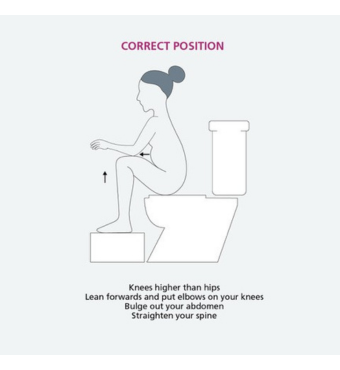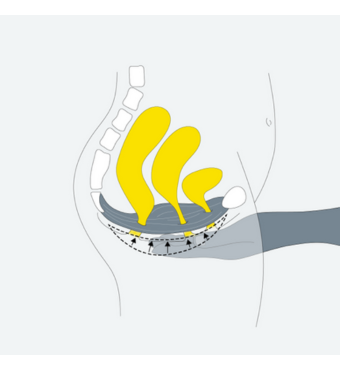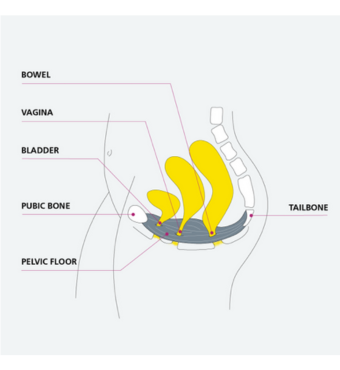Introduction
This information aims to help guide you through your recovery from your mesh removal surgery.
Length of stay
The length of stay in hospital after your operation will vary, some people can go home one day after their operation, but others will need longer.
After your operation
It is recommended that you get out of bed the same day as your operation, this will reduce your risk of blood clots and you are less likely to develop a chest infection. Moving around will also help if you have trapped wind and it encourages your bowel to recover quicker and return to its normal habits.
The nursing team will ensure you have adequate pain relief before getting out of bed. If your pain is not well controlled, please speak to your nurse. Please be aware that it is normal to have some pain after your procedure which can last for some time.
Breathing exercises
It is important to perform deep breathing exercises after your operation to reduce the risk of developing a chest infection.
- Do this by taking 3 deep breaths, feeling your lower ribs move.
- Repeat this every hour throughout the day.
If you need to cough after your operation, place a rolled-up towel across your abdomen and apply pressure. If you have had vaginal surgery, put your hand over the pad to support the perineum (the area between your vagina and back passage) when coughing.
Circulation
Regular movement of your legs is essential while you are less active than usual. Move your feet up and down at the ankles for 30 seconds every half an hour when you are in bed or sitting. You will also be given support stockings to wear whilst your mobility is reduced following your operation.
Getting out of bed
- Bend your knees up one at a time.
- Keep knees together and roll onto your side.
- Push up into sitting with your arms, at the same time lower your legs over the side of the bed.
- If you have had abdominal surgery you can support your incision with a rolled-up towel.
You can expect pain after your surgery. You will be provided with painkillers on discharge. Some painkillers, such as codeine, can cause constipation. Therefore, make sure to consume a high fibre diet and drink plenty of water to avoid constipation. Taking painkillers to reduce your pain will ensure that you get out of bed sooner and will therefore speed up your recovery and reduce the risk of blood clots.
Packs
You may have a pack (small gauze similar to a tampon) in your vagina to reduce the risk of bleeding. This will be removed by a nurse while you are in hospital.
Vaginal bleeding
You may have some vaginal bleeding for 6-8 weeks after your surgery. This is normal. However, if the bleeding becomes heavy or there is an offensive smell, you need to contact your GP or the hospital as this may signify an infection. Use sanitary towels instead of tampons to reduce the risk of infection.
Advice on going to the toilet
Bladder
You will have a urinary catheter (tube into your bladder to help it drain) in place after your operation that will be removed in hospital or in some cases you may be required to go home with the catheter still in place.
Once your catheter is removed you can go to the bathroom to empty your bladder. Ensure you sit on the toilet properly and relax your breathing. If you are struggling to empty your bladder it is important to speak to your nurse or GP. They will measure how much urine you pass and scan your bladder to determine how much is left.
You may notice that your urine flow is slower and it may take longer to empty your bladder. This should settle with time. If you have any symptoms of a urinary tract infection (UTI), e.g. burning when passing urine, offensive smelling urine or you are going to the toilet more often, please see your GP.
It is important to ensure you drink enough after your operation, approximately 1.5 to 2 litres per day, little and often is best. Try to avoid caffeinated drinks, fizzy drinks and alcohol as these may irritate your bladder and cause urgency. Drinking less frequently can make your urine more concentrated which can also irritate your bladder.
Try to avoid going to the toilet ‘just in case’ even if you have a fear of leaking as this can lead to poor bladder habits. There is over a 50% chance that your original urinary leakage will come back after your surgery, but this leaflet will teach you how to do pelvic floor exercises to hopefully improve this.
Bowels
It is important to avoid constipation after your operation as this puts extra strain on your pelvic floor muscles and potentially your operation site.
To prevent constipation, make sure you drink plenty of fluid, increase the fibre content in your diet and if necessary, use laxatives. Your doctor can prescribe these for you to take whilst in hospital and at home.

- Sit on the toilet a with a stool under your feet, as shown in the image on page 6.
- Do not strain and keep your tummy muscles relaxed.
- It is helpful to take a slow breath in through your nose so that your stomach moves outwards, and your chest remains still and then exhale through pursed lips.
- You may also find it useful to support your perineum (the area between your back passage and your vagina), when opening your bowels. Please see the image below.

Exercises
Pelvic floor exercises

Your pelvic floor muscles are a sling of muscles from the pubic bone at the front of your pelvis to the coccyx and sacrum at the back of your pelvis. They help to support the bowel, bladder and uterus, maintain bladder and bowel control, support the pelvis and aid sexual function.
It is important to strengthen these muscles leading up to and after your operation. Once your catheter has been removed and you can pass urine, you can gently start these exercises as soon as you are able to.
To contract your pelvic floor, tighten your back passage – as if you are stopping yourself passing wind. At the same time, tighten your vagina. Women used to be told to practice their pelvic floor muscle training by stopping the flow of urine. This is no longer recommended as it can affect your bladder function in the long term. Try to feel the muscles lifting upwards and forwards towards the pubic bone. Feel the muscles working together. Then relax, let go and feel the muscles return to their starting position. Try not to squeeze your buttocks or leg muscles. Avoid holding your breath and just continue to breathe normally.
To begin with, especially if you haven’t practiced these exercises before, you might lack confidence. Keep practicing the above and when you’ve mastered simply contracting and relaxing, move onto the next exercises. There are two different recommended pelvic floor exercises:
Exercise 1 - Slow pull-ups
- Tighten the pelvic floor muscles slowly. Continue to tighten for the length of the hold, relax, and feel the muscle let go. How many seconds can you hold the contraction for?
- Aim for 5 seconds to begin with, when you let go – can you feel the muscles relax?
- If not, you have held the contraction for too long, try again with a shorter hold – even just one second. Some women may only be able to only hold for 1-2 seconds. Others as many as 8-10 seconds. Don’t worry if you are not able to feel very much to start off with. It may take a bit of practice so keep going. The key is to discover your hold time, and gradually build this up to a maximum of 10 seconds. And don’t forget, keep breathing normally throughout.
- Rest for roughly 5 seconds in between each contraction, to ensure that the muscles have fully relaxed. Repeat this 5 times. As it gets easier, gradually increase the length of hold, and number of repetitions (aim for 10 long squeezes for 10 seconds each).
Exercise 2 - Fast pull-ups
- Tighten the pelvic floor muscles quickly. Let go straight away.
- Wait for a second.
- Repeat this 10 times and as you get more confident aim for approximately 1 contraction per second.
Pelvic floor exercise routine
Do exercise 1 and 2 during each session. As soon as you can, increase to 10 slow and 10 fast pull-ups. Aim to repeat each session at least 3 times a day. When you start, do the exercises lying or sitting. As your muscles get stronger progress to standing.
Do not expect immediate improvement – but do not give up. As the muscles get stronger you will be able to increase your hold time and number of repetitions. See our pelvic floor video to help guide you: How to do pelvic floor exercises - msk
Top tips
Try to get in the habit of tightening your pelvic floor muscles before you cough, sneeze or lift anything. If you are unable to correctly contract your pelvic floor muscles please speak to your nurse or consultant and they can refer you to pelvic health physiotherapy for a 1:1 session.
Abdominal exercises
After your operation it is important to start strengthening your deep abdominal muscles called Tranversus Abdominis. They work together with your pelvic floor muscles to provide support for your spine and internal organs.
Deep core muscles

- Lying on your back let your tummy relax, breath in gently.
- As you breathe out gently pull in the lower part of your tummy, hold for 5 seconds, and repeat 5 times.
- Do not move your back.
- You should be able to breathe and talk whilst exercising. This can also be done sitting or standing.
Pelvic tilting

- Lie on your back with your knees bent.
- Pull your tummy in and flatten your back on the bed.
- Hold, and then relax.
- Do not hold your breath.
- Repeat 5-10 times twice daily.
For exercise progressions please read: POGP Fit following surgery advice and exercise following gynaecological surgery leaflet (refer to the reference list).
General guidelines for returning to activity
It is normal to feel tired after your operation. Everyone recovers at different rates after surgery, but ensuring you have enough rest is important, as well as gradually building up your activity levels. This will assist your recovery and help reduce post-operative complications.
The following table should be used as a general guide.
| Removal of mesh surgery | |
|---|---|
| Healing stage | Activities |
| 0 - 2 weeks | No heavy lifting, e.g. no heavier than a full kettle. Short walks close to home for the first few days and then gradually increase your distance. Pelvic floor exercises and gentle abdominal exercises. |
| 2 - 4 weeks | No heavy lifting, e.g. no heavier than a full kettle. Short walks gradually increasing your distance. Continue with pelvic floor and abdominal exercises. |
| 4 - 6 weeks | Return to normal everyday activities. Continue with pelvic floor exercises. |
| 6+ weeks | Return to strenuous activities e.g. running. Increase your lifting. Continue with pelvic floor exercises. |
More information
If you are unsure about starting an activity or sport that requires heavy lifting or straining, please discuss this with your consultant.
For more information on recovering well from mesh removal surgery, please visit: The British Society of Urogynaecology (BSUG)
Driving
Do not drive until you are confident you can do an emergency stop. If you have undergone abdominal surgery, we advise you not to drive for at least 4 - 6 weeks but check with your insurance company regarding your policy.
Sex
You should avoid sexual intercourse for the first 6 weeks following surgery, ensuring any bleeding has stopped. This will allow tissues to heal and reduce the risk of developing an infection. It is important that you wait until you feel ready and use sufficient lubrication.
If you are concerned or intercourse remains uncomfortable after 3 - 4 months, it is a good idea to discuss this with your GP.
Useful Resources
References
Removal of a retropubic mesh sling
Home | The British Association of Urological Surgeons Limited
Anterior vaginal wall repair without the use of mesh
Home | The British Association of Urological Surgeons Limited
Recovery Guide Following Vaginal Repair Surgery/Vaginal Hysterectomy
Fit following Surgery advice and exercise following gynaecological surgery.
Leaflets from the Royal College of Obstetrics and Gynaecologists
- Laparoscopic hysterectomy.
- Pelvic floor repair.
- Vaginal hysterectomy.
- Abdominal hysterectomy.
© North Bristol NHS Trust. This edition published August 2023. Review due August 2026. NBT003580
Support your local hospital charity

See the impact we make across our hospitals and how you can be a part of it.

